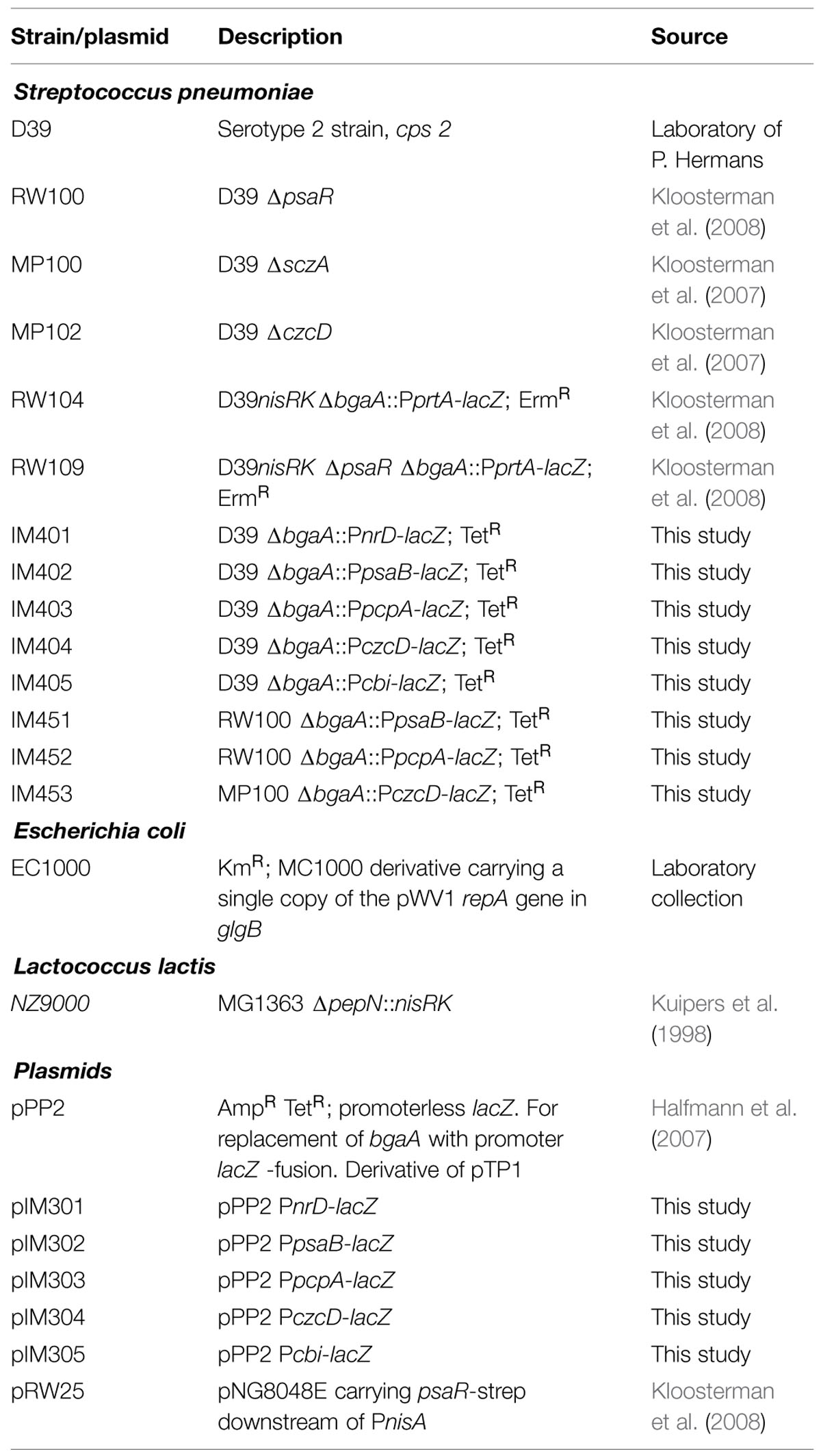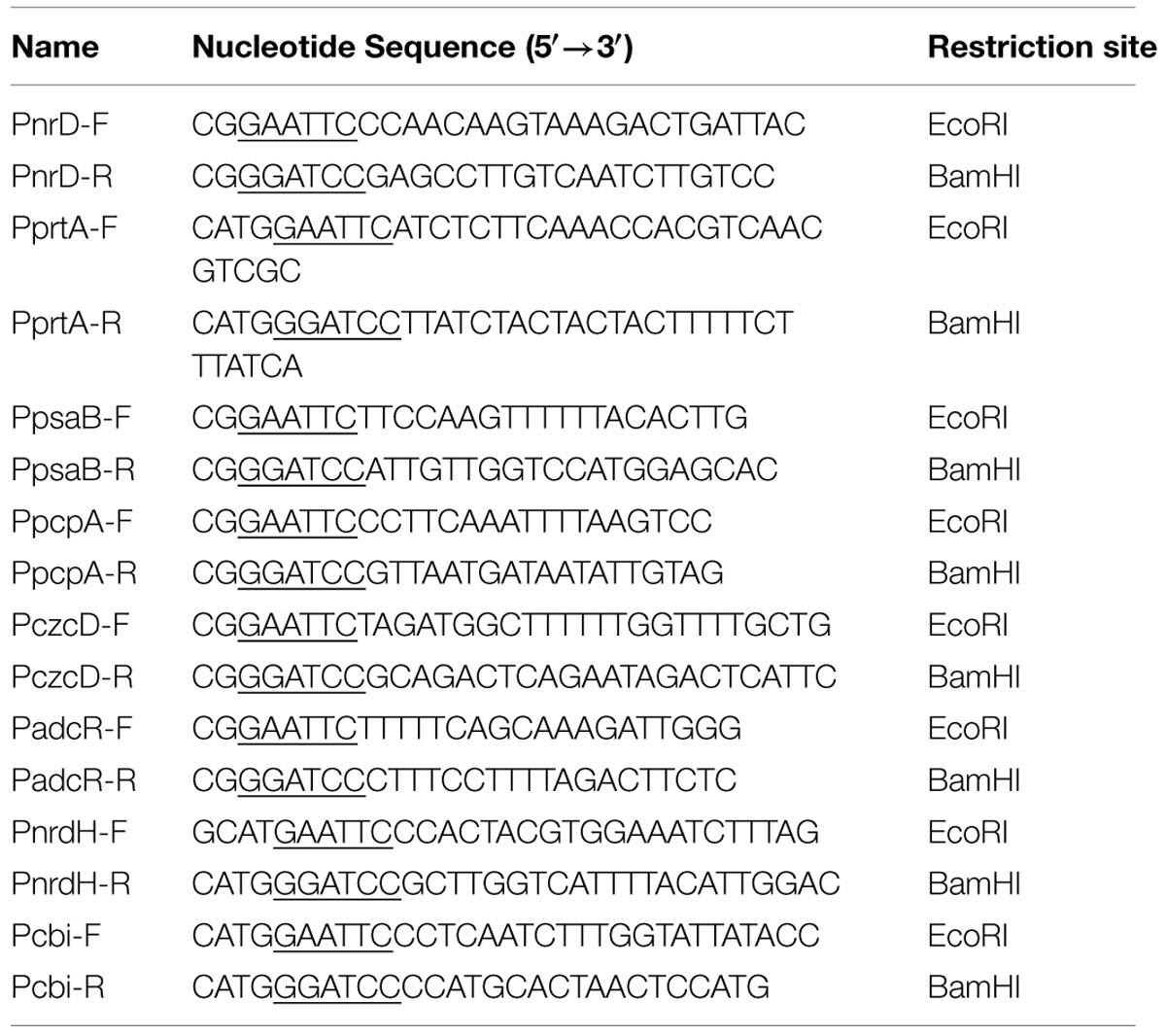- 1Department of Molecular Genetics, Groningen Biomolecular Sciences and Biotechnology Institute, University of Groningen, Groningen, Netherlands
- 2Department of Bioinformatics and Biotechnology, Government College University, Faisalabad, Pakistan
- 3Department of Microbiology, Tumor and Cell Biology, Karolinska Institutet, Stockholm, Sweden
Manganese (Mn2+)-, zinc (Zn2+)- and copper (Cu2+) play significant roles in transcriptional gene regulation, physiology, and virulence of Streptococcus pneumoniae. So far, the effect of the important transition metal ion cobalt (Co2+) on gene expression of S. pneumoniae has not yet been explored. Here, we study the impact of Co2+ stress on the transcriptome of S. pneumoniae strain D39. BLAST searches revealed that the genome of S. pneumoniae encodes a putative Co2+-transport operon (cbi operon), the expression of which we show here to be induced by a high Co2+ concentration. Furthermore, we found that Co2+, as has been shown previously for Zn2+, can cause derepression of the genes of the PsaR virulence regulon, encoding the Mn2+-uptake system PsaBCA, the choline binding protein PcpA and the cell-wall associated serine protease PrtA. Interestingly, although Mn2+ represses expression of the PsaR regulon and Co2+ leads to derepression, both metal ions stimulate interaction of PsaR with its target promoters. These data will be discussed in the light of previous studies on similar metal-responsive transcriptional regulators.
Introduction
The Gram-positive bacterium Streptococcus pneumoniae resides asymptomatically in the human nasopharynx (Bogaert et al., 2004). Nonetheless, when the immune system is compromised, it can spread to different niches inside the human body (Mitchell, 2003), where it may cause serious infections like pneumonia, sepsis, otitis media, or meningitis (Obaro and Adegbola, 2002; Kadioglu et al., 2008). During its route from the nasopharynx to other parts of the human body, it is exposed to different levels of macro- and micronutrients, including varying concentrations of transition metal ions, which can affect the expression of various genes involved in virulence as well as metabolic processes (Gupta et al., 2009; Shafeeq et al., 2011a, 2013).
The transition metal ions such as manganese (Mn2+), zinc (Zn2+), copper (Cu2+), cobalt (Co2+), iron (Fe2+), and nickel (Ni2+) are indispensable components of many biological processes, forming a structural component of biomolecules, being involved in cellular and subcellular functions, and acting as catalytic cofactors in reversible oxidation–reduction and hydrolytic reactions for all forms of life (Lippard and Berg, 1994; Blencowe and Morby, 2003). An excess of metal ions can be very toxic to bacteria (Nies, 2003; Moore and Helmann, 2005). Therefore, proper homeostasis of metal ions is important for the survival of bacteria and is maintained by various transport- and efflux systems that are tightly regulated by metal-dependent transcriptional regulators, thus ensuring the balance of metal ions within the cell (Tottey et al., 2008; Waldron and Robinson, 2009; Lisher et al., 2013). In addition to this, the interplay of and competition between different metal ions also play an important role in the regulation of metal ion homeostasis and physiology in bacteria (Dudev and Lim, 2008; Jacobsen et al., 2011).
Co2+ is an important transition metal ion for many bacteria (Nies, 1992) and takes the fourth position in the Irving–Williams stability series, where the order is Mn2+< Fe2+< Co2+< Ni2+< Cu2+> Zn2+ (Irving and Williams, 1953). The concentration of Co2+ in the human blood and serum is 0.12 ng ml-1 and 0.19 ng ml-1, respectively (Alimonti et al., 2005). However, during certain conditions the Co2+ level in the human body fluids can be increased over 20 times, such as after metal-on-metal (MoM) hip arthroplasties, or upon high level exposure in regions with elevated environmental Co2+ levels (Jantzen et al., 2013; Cheyns et al., 2014). In pathogenic bacteria like Mycobacterium tuberculosis and Staphylococcus aureus Co2+-transport was linked to virulence (Remy et al., 2013; Raimunda et al., 2014). The role of Co2+ for S. pneumoniae has not been studied yet, but since there is a high number of proteins with Co2+-binding capacity in S. pneumoniae, this metal ion could be relevant for the lifestyle of this pathogenic bacterium as well (Honsa et al., 2013; Sun et al., 2013).
The transport of Co2+ has not been studied extensively in bacteria. The Ni2+/Co2+ permease family, NiCoT, is widely distributed in bacteria, fungi, and archaea and can transport Ni2+ and Co2+ selectively (Degen et al., 1999; Degen and Eitinger, 2002). Proteins from the NiCoT family are present in many Gram-positive bacteria including Lactococcus lactis and S. thermophilus (Lorca et al., 2007). In Salmonella typhimurium, the three genes cbiN, cbiQ, and cbiO are likely to encode an active Co2+-transport system (Roth et al., 1993). A comparative and functional genome analysis of the “cbi” system (cbiMNQO) showed that it constitutes a widespread Co2+-transport system in prokaryotes (Rodionov et al., 2006). S. pneumoniae also encodes the putative Co2+-transport genes cbiO-I, cbiO-II, and cbiQ, which show sequence similarity with the Co2+-transport genes in other prokaryotes. The Co2+-mediated whole genome response of S. pneumoniae has not been studied before. So far, the only gene of which expression was shown to be regulated by Co2+ is czcD, which is mediated by the TetR family transcriptional regulator SczA. Although mainly involved in Zn2+ homeostasis, CzcD slightly contributes to resistance to Co2+ stress as well (Kloosterman et al., 2007).
We aimed at identifying genes of which expression was influenced by a high level of Co2+ in S. pneumoniae. For this purpose, we have used whole transcriptome analysis and found a number of genes/operons that were differentially expressed under Co2+ stress, including czcD, psaBCA, pcpA, prtA, and cbi, encoding a Zn2+-resistance system, a Mn2+-uptake system, a choline binding protein, a cell-wall associated serine protease and putative Co2+-transport proteins, respectively. On the basis of our transcriptome analyses, β-galactosidase assays and electrophoretic mobility shift assays (EMSAs), we demonstrate that Mn2+ and Co2+ have an opposite effect on the regulation of the PsaR regulon, where Mn2+ represses while Co2+ derepressess expression of the PsaR regulon. Moreover, we show that expression of the cbi operon and the Zn2+-efflux gene czcD increases with increasing concentration of Co2+, suggesting a link of these genes with Co2+ homeostasis as well.
Materials and Methods
Bacterial Strains, Growth Conditions, and DNA Manipulation
Bacterial strains and plasmids used in this study are listed in Table 1. S. pneumoniae D39 wild-type (WT) was grown at 37°C in chemically defined medium (CDM) and 1% Chelex 100 resin (Bio-Rad) treated CDM (Kloosterman et al., 2006b). For 1% Chelex 100 resin (Bio-Rad) treatment, CDM was prepared without the addition of a metal mixture (a component of CDM medium) and after Chelex treatment, the metal mixture was added in the medium. The metal mixture was prepared by keeping MgCl2, CaCl2, and CuSO4 constant as specified in normal CDM and salts of other metal ions MnSO4, ZnSO4, CoCl2, FeCl2 and NiSO4 were added separately as specified in the Results section. Escherichia coli strain EC1000 was cultured at 37°C. Where necessary for selection, media were supplemented with the following concentrations of antibiotics: erythromycin: 0.25 μg ml-1 and tetracycline: 2.5 μg ml-1 for S. pneumoniae; chloramphenicol: 4 μg ml-1 for L. lactis; ampicillin: 100 μg ml-1 for E. coli. All bacterial strains used in this study were stored in 10% (v/v) glycerol at -80°C. Primers used in this study are listed in Table 2, and are based on the sequence of S. pneumoniae D39 genome. Chromosomal DNA of the S. pneumoniae D39 strain was used as a template for PCR amplification (Avery et al., 1995; Lanie et al., 2007).
Reverse Transcription (RT)-PCR
To confirm that the cbi gene cluster transcribes as a single transcriptional unit, D39 WT was grown in CDM with 0.5 mM Co2+ and total RNA was isolated from cells grown till mid-exponential phase of growth (OD600 = 0.2) as described (Shafeeq et al., 2015). In short, cells were harvested by centrifugation for 2 min at 10,000 rpm at 4°C. Cell pellets were resuspended in 400 μl of nuclease free water (DEPC-treated), after which 50 μl of 10% SDS, 500 μl of phenol/chloroform (1:1) and 500 mg glass beads were added. Total RNA was isolated using the Roche RNA isolation Kit. DNA contamination was eliminated from the RNA sample by treatment with 2 U of RNase free DNase I (Invitrogen, Paisley, UK). cDNA samples were prepared by using superscript III RT and random nanomers at 42°C for 16 h. The intergenic regions IRI to IRVII (Figure 1) were amplified by primer pairs mentioned in Table 2. For fair comparison of PCR products, 100 ng of RNA and 30 ng of DNA were used.
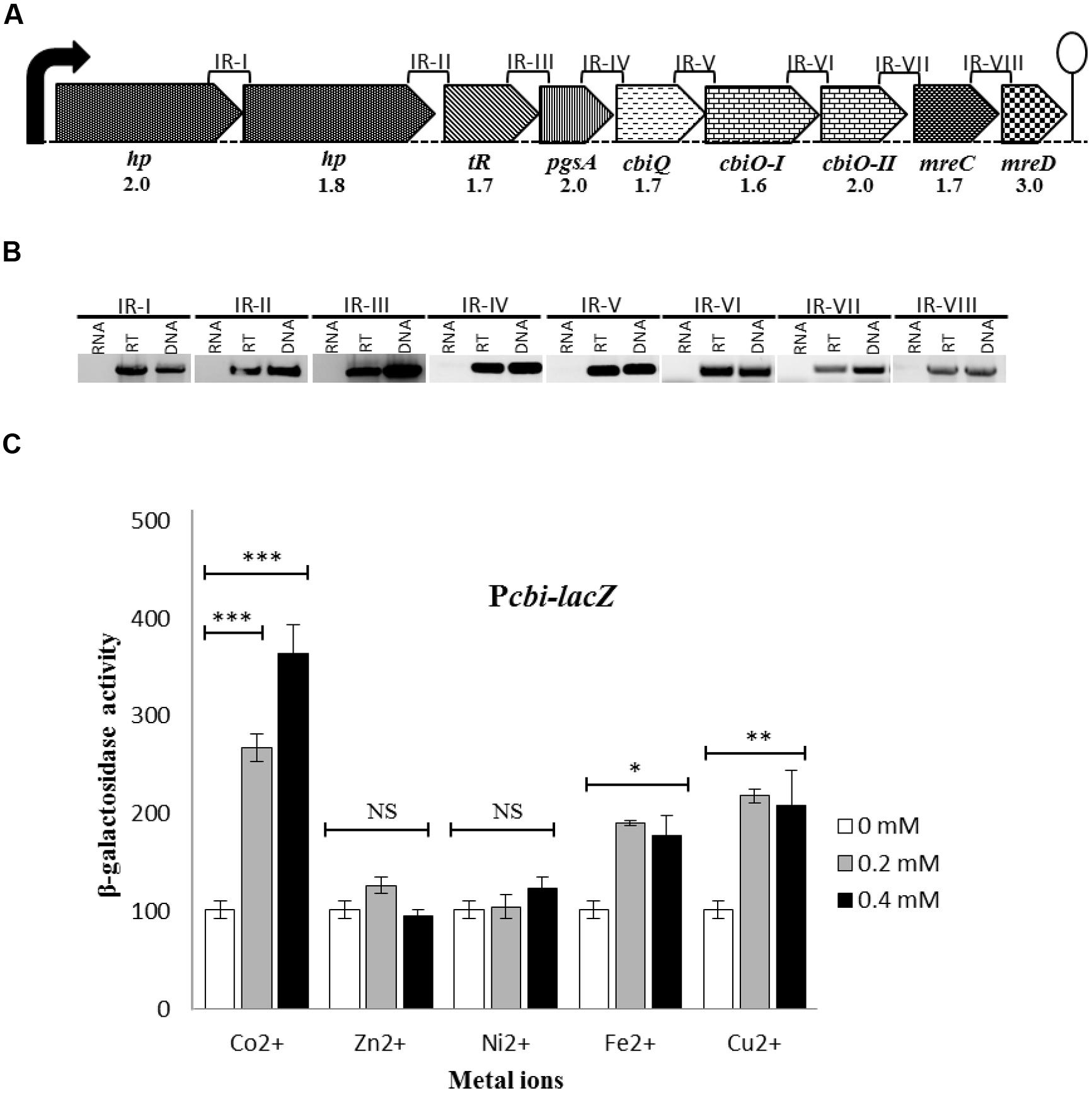
FIGURE 1. (A) Organization of the putative cbi operon. The lollipop indicates the putative transcriptional terminator. Black arrow represents the promoter region. Expression ratios of the cbi operon as determined by the transcriptome analysis [chemically defined medium (CDM) + 0.5 mM Co2+/CDM + 0 mM Co2+] are indicated underneath. (B) Confirmation of the polycistronic nature of the cbi operon by Reverse Transcription (RT)-PCR analysis. Total RNA was isolated from the D39 wild-type (WT) grown in CDM + 0.5 mM Co2+. RT-PCR was performed with and without RT treatment using primer pairs for the intergenic regions IR-I to IR-VIII. Genomic DNA of D39 WT was taken as a positive control. (C) Expression level (in Miller units) of a Pcbi-lacZ-fusion in D39 WT in CDM supplemented with different concentrations of Co2+, Ni2+, Zn2+, Fe2+, and Cu2+. SD of three independent replications is indicated with error bars. Statistical significance of the differences in the expression levels was determined by one-way ANOVA (NS, not significant, ∗P < 0.05, ∗∗P < 0.001, and ∗∗∗P < 0.0001).
Inductively Coupled Plasma-Mass Spectrometry (ICP-MS) Analysis
For Inductively coupled plasma-mass spectrometry (ICP-MS) analysis, S. pneumoniae strain D39 was grown in CDM with and without 0.5 mM Co2+ till mid-exponential phase (OD600 = 0.25 for 0 mM Co2+ and OD600 = 0.2 for 0.5 mM Co2+) of growth. Cultures were centrifuged and washed (at 4°C) twice with the CDMchelex medium and twice with overnight Chelex (Sigma) treated phosphate-buffered saline (PBS) with 1 mM nitrilotriacetic. The cell pellets were dried overnight in a Speedvac at room temperature. The dried cells were lysed in 2.5% nitric acid (Ultrapure, Sigma–Aldrich) for 10 min at 95°C by vigorous vortexing after 15 s. The lysed cell samples were used for ICP-MS analysis as described before (Jacobsen et al., 2011). Moreover, ICP-MS analysis was also performed on CDM, CDMchelex, CDM-Mn2+, and CDMchelex-Mn2+ media. Metal ion concentrations were expressed as μg g-1 dry weight of cells and in μg l-1 in case of plain CDM.
Construction of lacZ-Fusions and β-Galactosidase Assays
Transcriptional lacZ-fusions to the promoters of nrdD, psaB, pcpA, czcD, and the cbi operon were constructed in pPP2 (Halfmann et al., 2007) with the primer pairs listed in Table 2. The PCR products were digested and cloned into the EcoRI/BamHI sites of pPP2 resulting in plasmids pIM301-305. E. coli EC1000 was used as cloning host. The pIM301-305 were transformed into D39 WT resulting in strains IM401-406, whereas pIM302-303 were also introduced into the RW100 (ΔpsaR) strain (Kloosterman et al., 2008), resulting into strains IM451-452. pIM305 was introduced into MP100 (ΔsczA) strain (Kloosterman et al., 2007), resulting into strain IM453. All plasmids were checked for the presence of the correct insert by means of PCR and DNA sequencing.
For β-galactosidase assays, derivatives of S. pneumoniae D39 were grown in triplicate in CDM and CDMchelex at 37°C supplemented with different metal ion concentrations as mentioned in the “Results” section. Cells were harvested at the mid-exponential phase of growth (OD600 = 0.2). Cells were treated with mixture of Z-buffer [Na2HPO4∗2H2O (60 mM), NaH2PO4∗H2O (40 mM), KCl (10 mM), MgSO4∗7H2O (1 mM)] and CTAB (Cetyltrimethylammonium bromide). Four milligram per milliliter of ortho-Nitrophenyl-β-galactoside (ONPG) was added to start the reaction. The reactions were stopped with the addition of Na2CO3 and β-galactosidase activity was measured as described before (Kloosterman et al., 2006b). SD for each sample was calculated from three independent biological replicates.
Overexpression and Purification of Strep-Tagged PsaR
The overexpression of C-terminally Strep-tagged PsaR (Kloosterman et al., 2008) was achieved by mean of the nisin-inducible system (NICE) in L. lactis strain NZ9000 (Kuipers et al., 1998). Cells were grown till an OD600 of 0.5 and then induced with 5 ng ml-1 nisin in 1 L culture. After 2 h of nisin induction, the cell culture was harvested and resuspended in 10 ml buffer A (0.25 M NaCl, 10 mM MgCl2, 2 0 mM Tris-HCl, pH 8, 10% glycerol, 1 mM β-mercaptoethanol) with 1 mg/ml lysozyme and one tablet of protease inhibitor cocktail (Complete Mini, Roche). After half hour incubation at 30°C cells were sonicated on ice and cell debris was removed by centrifugation. Purification of PsaR-Strep was performed using the Streptactin column from IBA according to the supplier’s instructions (www.iba-go.com). Buffers without EDTA were used, and the purified protein was stored at a concentration of 0.2 mg/ml in the elution buffer (100 mM Tris-HCl [pH 8], 150 mM NaCl, 2.5 mM desthiobiotin, 1 mM β-mercaptoethanol) with 10% glycerol at -80°C.
Electrophoretic Mobility Shift Assays
Electrophoretic mobility shift assays were performed as described (Kloosterman et al., 2008). In short, PCR products of PpsaB, PpcpA, PprtA, and PadcR were labeled with [γ-33P] ATP. EMSAs were carried out in buffer containing 20 mM Tris-HCl (pH 8.0), 5 mM MgCl2, 8.7% (w/v) glycerol, 62.5 mM KCl. 25 μg/ml bovine serum albumin, 25 μg/ml poly(dI-dC) and 5000 cpm of [γ-33P] ATP-labeled PCR product. Reactions were incubated at 30°C for 30 min before loading on gels. Gels were run in 1 M Tris-borate buffer (pH 8.3) at 95 V for 90 min.
DNA Microarray and Data Analysis
For DNA microarray analysis to investigate Co2+ stress, the transcriptome of S. pneumoniae D39 WT, grown in 2 biological replicates in CDM with 0.5 mM CoCl2 was compared to the transcriptome of the same strain grown in two biological replicates in CDM with 0 mM CoCl2. Cells were harvested at mid-exponential phase of growth by means of centrifugation for 2 min at 11000 rpm at 4°C and immediately frozen in liquid nitrogen. RNA isolation and cDNA synthesis was performed as described before (Shafeeq et al., 2015). Cy3/Cy5 labeling of cDNA was performed with the Cyscribe post Labeling Kit (Amersham Bioscience). Hybridization was performed with labeled cDNA for 16 h at 45°C in Ambion SlideHyb #1 hybridization buffer on super amine glass slides (Array-It, SMMBC). Slides were scanned with a Genepix 4200 laser scanner at 10 μm resolution. Genepix software (GenePix® Pro 7) was used to analyze the slides. The MicroPrep software package was used to analyze the raw data further. The expression ratio of the signals of D39 grown in CDM with 0.5 mM Co2+ over D39 grown in CDM with 0 mM Co2+ was calculated from the data of at least seven spots by Cyber-T. A gene was considered differentially expressed when the Bayesian p-value <0.001 and a fold change cut-off of 2 was applied. The transcriptomic data have been submitted to GEO (Gene Expression Omnibus) with accession number GSE57696.
Results
Organization of the cbi Operon in S. pneumoniae D39
The important transition metal ion Co2+ is usually taken up by bacterial cells from the outer environment through specific transport systems like CbiMNQO (Roth et al., 1993; Rodionov et al., 2006). BLAST searches with the CbiMNQO sequences revealed the presence of putative Co2+-transport genes in S. pneumoniae D39 as well (Supplementary Figure S1). These genes are organized within a cluster of nine genes (SPD2052-2044) and most likely this cluster of genes is transcribed as a single transcriptional unit (Figure 1A). Due to high homology of these genes with putative Co2+-uptake genes in other bacteria, here, we will name this operon as a cbi operon.
The first two genes (SPD2052–SPD2051) of the cbi operon encodes a peptidase, i.e., a M16 family protein, and a hypothetical protein, which have homology with Zn2+-dependent proteases and peptidases, respectively. The third gene (SPD2050) of the cbi operon is a putative transcriptional regulator that belongs to the XRE (Xenobiotic Response Element) family of transcriptional regulators. This is the second most occurring family of transcription regulators in bacteria and has diverse metabolic functions. The fourth gene in the cbi operon is pgsA (SPD2049) encoding CDP-diacylglycerol-glycerol-3-phosphate 3-phosphatidyltransferase. This gene is involved in phospholipid biosynthesis in Rhodobacter sphaeroides and is predicted to be essential for the survival of Streptococcus mutans (Dryden and Dowhan, 1996; MacGilvray et al., 2012). Downstream of pgsA, three genes, i.e., cbiO-I, cbiO-II, and cbiQ (SPD2048–SPD2046) are present. cbiO-I and cbiO-II putatively encode a Co2+ ATP-binding transporter subunit, whereas cbiQ encodes a Co2+-ABC transporter permease. BLAST searches showed that the cbiO-I and cbiO-II genes of S. pneumoniae are conserved in different streptococci and also have a sequence similarity with the cbiO gene of other bacteria, a gene that has been shown to be involved in Co2+-transport (Roth et al., 1993; Rodionov et al., 2006). Following cbiQ, mreC, and mreD (SPD2045–SPD2044) that encode rod shape-determining proteins, are present. MreC and MreD are involved in the synthesis of peptidoglycan in many bacteria (Carballido-López and Formstone, 2007; Bendezu and de Boer, 2008). In Bacillus subtilis, the overexpression of mreC and mreD stimulate protease production (Kubo et al., 1996). In S. pneumoniae, the exact role of MreC and MreD is not known yet, but both of the genes have been shown to be essential for the growth of S. pneumoniae D39 (Land and Winkler, 2011).
To confirm that the cbi operon is transcribed as a single transcriptional unit, all the intergenic regions between these nine genes (IRI to IRVIII) were analyzed by RT-PCR (Figure 1B). Our RT-PCR data showed that the cbi operon is indeed transcribed as a single transcriptional unit (Figure 1B). Moreover, recent RNA-seq data of S. pneumoniae also support our RT-PCR data that the cbi operon is transcribed as a single transcriptional unit starting from SPD2052 and ending with SPD2044 (GSE54199; Slager et al., 2014).
Co2+-Dependent Expression of the cbi Operon in S. pneumoniae D39
The presence of three putative Co2+-transport genes in the cbi operon suggests its putative role in metal ion transport. To investigate the effect of different concentrations of various metal ions (Co2+, Ni2+, Zn+2, Fe2+, and Cu+2) on the expression of the cbi operon (as measured by an ectopic Pcbi-lacZ transcriptional fusion) of S. pneumoniae, we performed β-galactosidase assays. The measurement of β-galactosidase activity revealed that expression of Pcbi-lacZ increased significantly in the presence of Co2+ compared to other tested metal ions. Fe2+ and Cu2+ also slightly increase the expression of Pcbi-lacZ compared to the control (Figure 1C), but the increase in the expression of Pcbi-lacZ to Fe2+ and Cu2+ was less compared to Co2+. These data suggest that the expression of the cbi operon is Co2+-dependent.
Identification of Co2+-Dependent Genes in S. pneumoniae
To investigate the genome-wide influence of Co2+ stress in S. pneumoniae, a transcriptome analysis was performed using the D39 WT strain grown in CDM (Kloosterman et al., 2006a) either with 0.5 mM or 0 mM Co2+ (Table 3). Expression of the cbi operon encoding (putative) Co2+ transporters was affected by Co2+ (Figure 1A). Upregulation of the cbi operon further confirmed the Co2+-dependent expression of the cbi operon as seen with the β-galactosidase assays mentioned above. Identification of the gene encoding the Zn2+-efflux system CzcD in the Co2+ responsive set of genes, as well as the downstream gene adhC, encoding a Zn2+-containing alcohol dehydrogenase, is in agreement with previous findings (Kloosterman et al., 2007). The same holds for upregulation of the nrd operon, involved in synthesis of deoxyribonucleoside triphosphate (Jordan and Reichard, 1998; Torrents et al., 2001), by Co2+ stress (Kloosterman et al., 2007).
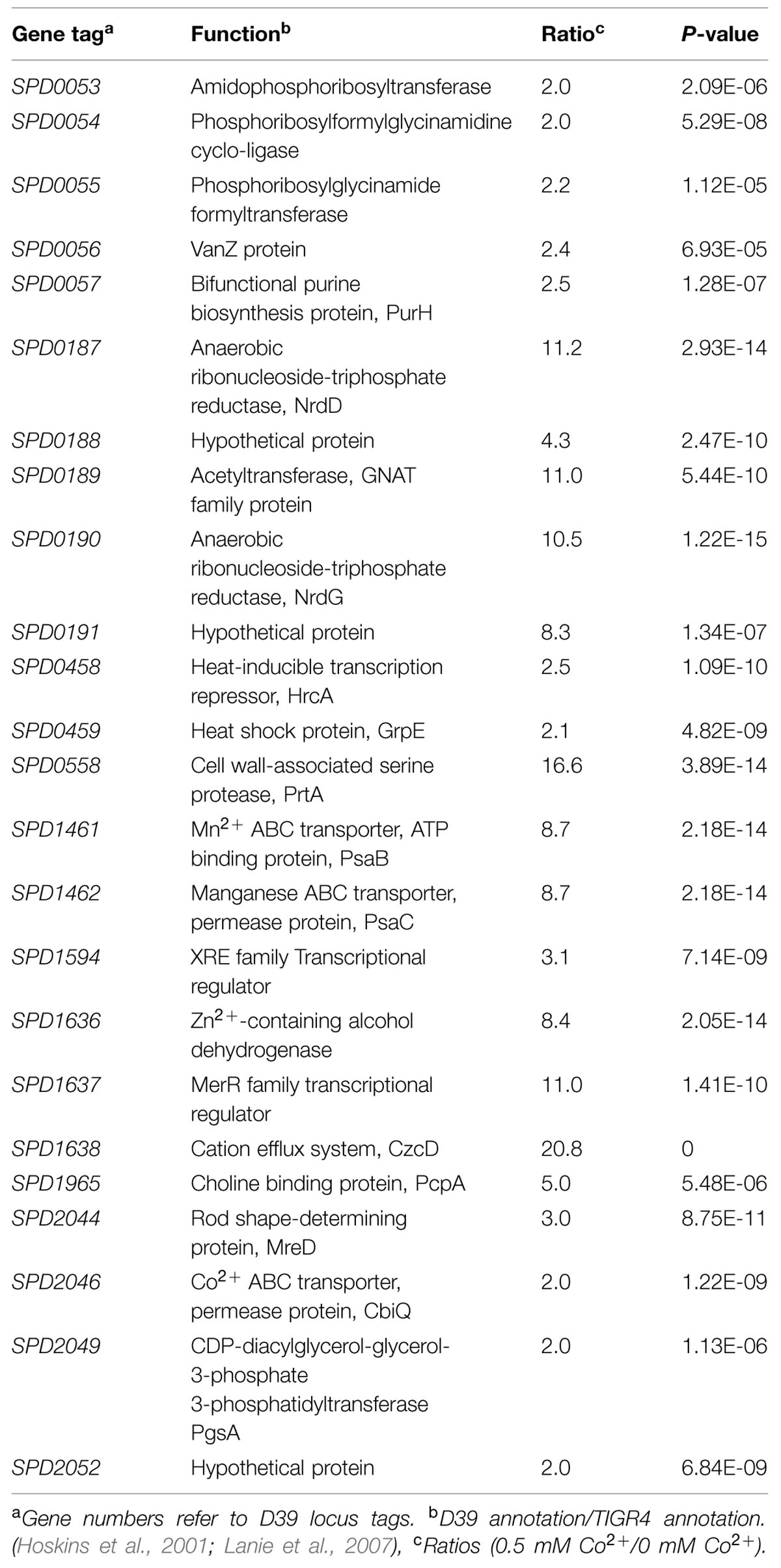
TABLE 3. Summary of transcriptome comparison of S. pneumoniae D39 wild-type grown in chemically defined medium (CDM) plus 0.5 mM Co2+ and CDM plus 0 mM Co2+.
Interestingly, a number of virulence genes were upregulated by Co2+ stress, namely psaBCA, pcpA, and prtA, encoding a Mn2+-dependent ABC transporter (McAllister et al., 2004), a choline binding protein (Sánchez-Beato et al., 1998) and a serine protease (Bethe et al., 2001; Mirza et al., 2011), respectively. The regulation of these genes has been shown before to be dependent on the balance between the concentrations of Mn2+ and Zn2+ via the transcriptional regulator PsaR (Johnston et al., 2006; Kloosterman et al., 2008; Honsa et al., 2013). Based on our observation, we speculated PsaR to play a role in the regulation of these genes in the presence of Co2+ as well.
Two transcriptional regulators showed increased expression under Co2+ stress. SPD1594, belonging to the XRE family that has homology with a Zn2+-dependent peptidase, was previously found to be upregulated during Zn2+-limitation (Shafeeq et al., 2011a), suggesting that Co2+ and Zn2+ have opposite effects on its expression. The second, HrcA, a heat-inducible transcription repressor, has previously been shown to be involved in repression of dnaK, a chaperone protein, and groE, a chaperonin, in the presence of Ca2+ (Kwon et al., 2005; Kim et al., 2008). Upregulation of the HrcA regulon may indicate that a high concentration of Co2+ causes stress to the cell. Overall, Co2+ stress induces broad transcriptomic changes in S. pneumoniae.
Effect of Co2+ on the PsaR-Mediated Expression of the Virulence Genes pcpA, psaBCA, and prtA
To investigate the transcriptional response of prtA, pcpA, and psaBCA under different Co2+ concentrations, transcriptional lacZ-fusions with the respective promoters of pcpA and psaBCA were constructed in plasmid pPP2 (Halfmann et al., 2007) and prtA transcriptional lacZ-fusion was constructed in pORI13 (Kloosterman et al., 2008), and introduced into D39 WT. The strains containing the PpcpA-lacZ, PpsaB-lacZ, and PprtA-lacZ transcriptional fusions were grown in CDM (Complete CDM), CDM-Mn2+ (CDM without Mn2+), CDMchelex (Complete CDM treated with Chelex) and CDMchelex-Mn2+ (CDM without Mn2+ treated with Chelex) with addition of Co2+ and Zn2+. Mn2+-depleted medium was used, since the binding affinity of Mn2+ with PsaR is very high compared to other metal ions (Zn2+ or Co2+; Lisher et al., 2013). The measurement of β-galactosidase activity revealed higher expression of the PpcpA-lacZ, PpsaB-lacZ, and PprtA-lacZ transcriptional fusions in Mn2+-depleted medium (CDM-Mn2+ and CDMchelex-Mn2+) compared to CDM/CDMchelex, which might be due to Mn2+ starvation (Figure 2A and Supplementary Figure S2). The further addition of Co2+/Zn2+ leads to higher expression of PpcpA-lacZ, PpsaB-lacZ, and PprtA-lacZ (Figure 2A and Supplementary Figure S2), suggesting that the derepression of the PsaR regulon is not specific to Mn2+ starvation but also Co2+ and Zn2+ have a derepressive effect. We also observed that at the same concentration of Co2+ and Zn2+ the effect of Co2+ on the expression of the PsaR regulon is stronger compared to that of Zn2+.
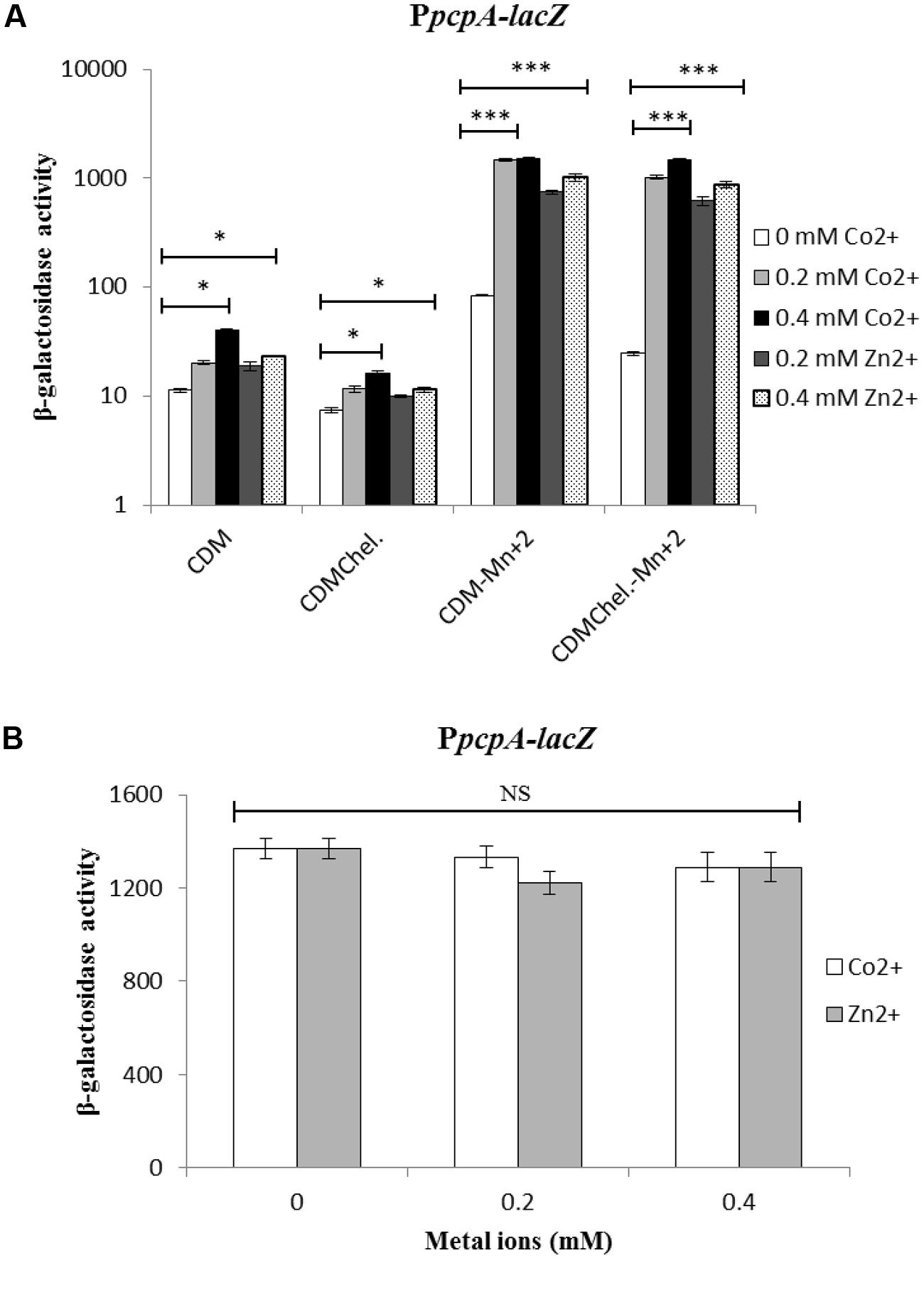
FIGURE 2. (A) Expression level (in Miller units) of PpcpA-lacZ in D39 WT in CDM, CDM-Mn2+, CDMchelex, and CDMchelex-Mn2+ supplemented with different concentrations of Co2+ and Zn2+. (B) Expression level (in Miller units) of PpcpA-lacZ in ΔpsaR strain. SD of three independent replications is indicated with error bars. Statistical significance of the differences in the expression levels was determined by one-way ANOVA (NS, not significant, ∗P < 0.05, and ∗∗∗P < 0.0001).
It is likely that, besides the response to Mn2+ and Zn2+ (Kloosterman et al., 2008), PsaR also mediates the expression of PpcpA-lacZ, PpsaB-lacZ, and PprtA-lacZ in the presence of Co2+. To verify this hypothesis, the PpcpA-lacZ, PpsaB-lacZ, and PprtA-lacZ were transformed into the clean knockout strain of psaR (Kloosterman et al., 2008). β-galactosidase activity showed that the expression of PpcpA-lacZ, PpsaB-lacZ, and PprtA-lacZ were derepressed in the ΔpsaR strain and independent of the presence of Co2+ (Figure 2B and Supplementary Figure S3).
To determine the effect of Co2+ in conjunction with other metal ions on gene expression mediated by PsaR, β-galactosidase activity of PpcpA-lacZ and PpsaB-lacZ was measured using different concentrations of Co2+, Mn2+, and Zn2+. This showed that the expression of PpcpA-lacZ increased with a gradual increase in the concentration of Co2+ at a constant concentration of Zn2+ (Figure 3A) in CDM-Mn2+. 0.2 mM of Zn2+ was used because at this concentration maximum expression of PpcpA-lacZ was observed. It has been shown previously that Mn2+ can inhibit the activation of the PsaR regulon by PsaR even in the presence of Zn2+. Therefore, we decided to also check if Co2+ and Mn2+ influence each other’s effects. We kept the concentration of Co2+ constant and gradually increased the concentration of Mn2+ from 0.01 mM to 0.1 mM. As expected, the expression of PpcpA-lacZ was decreased with increasing concentrations of Mn2+ (Figure 3B). This indicates that Mn2+ can also nullify the Co2+-dependent depression of the PsaR regulon. However, this Mn2+-dependent repression of the PsaR regulon in the presence of Co2+ is less strong compared to when Zn2+ is present instead.
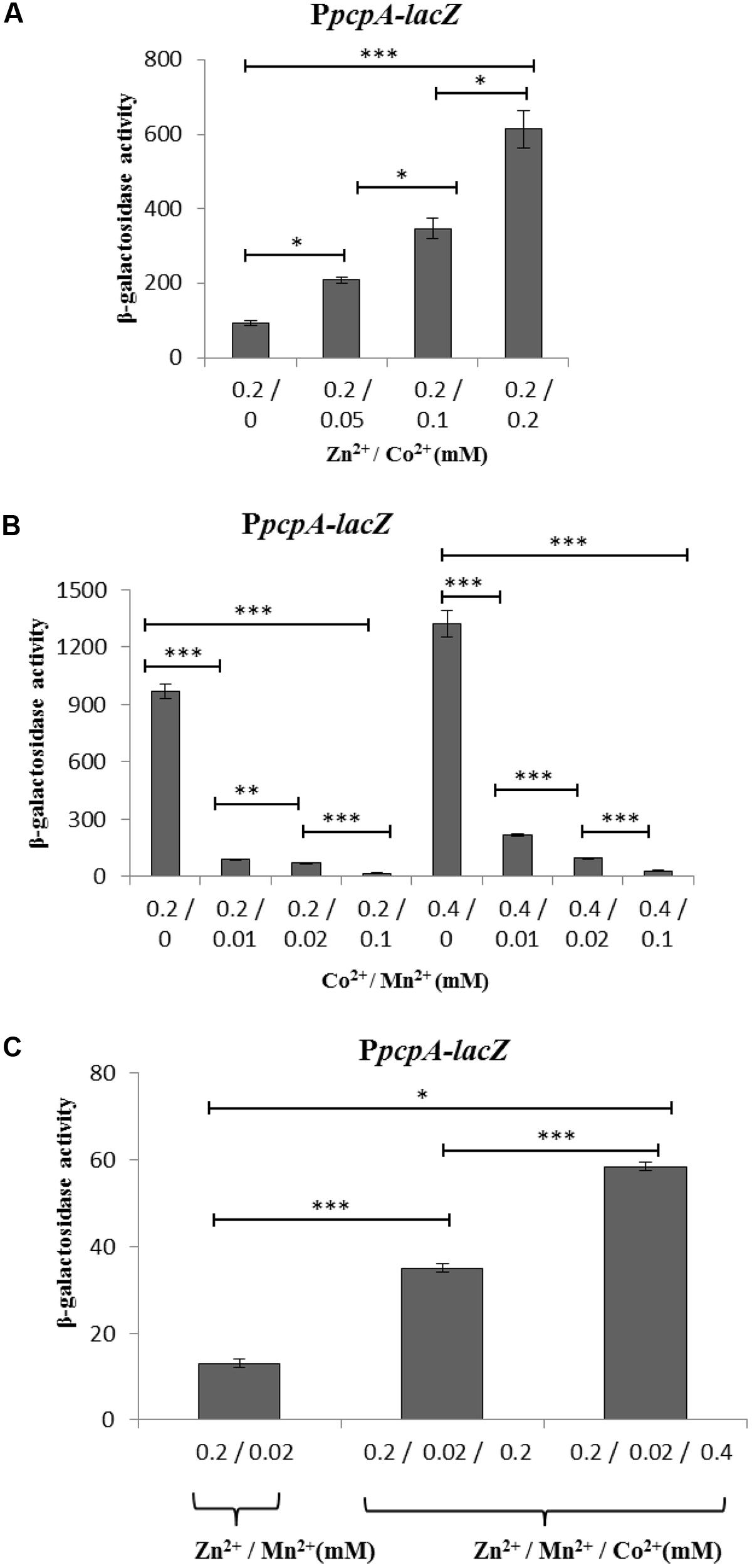
FIGURE 3. Expression level (in Miller units) of PpcpA-lacZ in D39 WT in CDM (without Mn2+ addition) supplemented with different concentrations of Co2+ and Zn2+ (A), with different concentrations of Co2+ and Mn2+ (B), and with different concentrations of Co2+, Mn2+, and Zn2+ (C). SD of three independent replications is indicated with error bars. Statistical significance of the differences in the expression levels was determined by one-way ANOVA (NS, not significant, ∗P < 0.05, ∗∗P < 0.001, and ∗∗∗P < 0.0001).
In further experiments, we kept the concentration of Mn2+ and Zn2+ constant, while increasing the concentration of Co2+ in the medium and performed β-galactosidase assays with PpcpA-lacZ. β-galactosidase activity showed that the expression of PpcpA-lacZ was increased with increasing concentrations of Co2+ at a constant concentration of Mn2+ and Zn2+ (Figure 3C). The same trend of expression was also observed for PpsaB-lacZ (Supplementary Figure S4). Next to using lacZ transcriptional reporter assays, qRT-PCR data of the genes in the PsaR regulon in the presence of high Co2+ are also in line with our transcriptome analysis (Supplementary Table S1).
ICP-MS Analysis of Intracellular Mn2+ and Co2+ in S. pneumoniae
To quantify the exact concentration of metal ions in the media that were used in this study, ICP-MS analysis was performed. Concentrations of different metal ions measured by ICP-MS in CDM, CDMchelex, CDM-Mn2+, and CDMchelex-Mn2+ are summarized in Supplementary Table S2. ICP-MS analysis revealed the concentration of Mn2+ present in CDM and CDMChelex is 5–7 μM, which is already enough to cause Mn2+-dependent repression of psaBCA, pcpA, and prtA by PsaR (Kloosterman et al., 2008), and also explains why we did not observe a big difference in the expression of psaBCA, pcpA, and prtA between CDM and CDMchelex.
To investigate whether the transcriptome effects observed above in the presence of 0.5 mM Co2+ correlate with a high cell-associated concentration of Co2+, ICP-MS analysis was performed on whole cell extract. For this purpose, cells were grown in CDM without and with 0.5 mM added Co2+. The concentrations of cell-associated metal ions in S. pneumoniae D39 grown with or without 0.5 mM Co2+ are given in Table 4. Interestingly, no difference in the cell-associated amount of Mn2+ was observed in the cells grown in medium with 0 mM Co2+ compared to the cells grown in medium with 0.5 mM Co2+. Thus, the effect of Co2+ on the expression of the PsaR regulon might be direct, rather than indirectly via a change in the intracellular concentration of Mn2+.
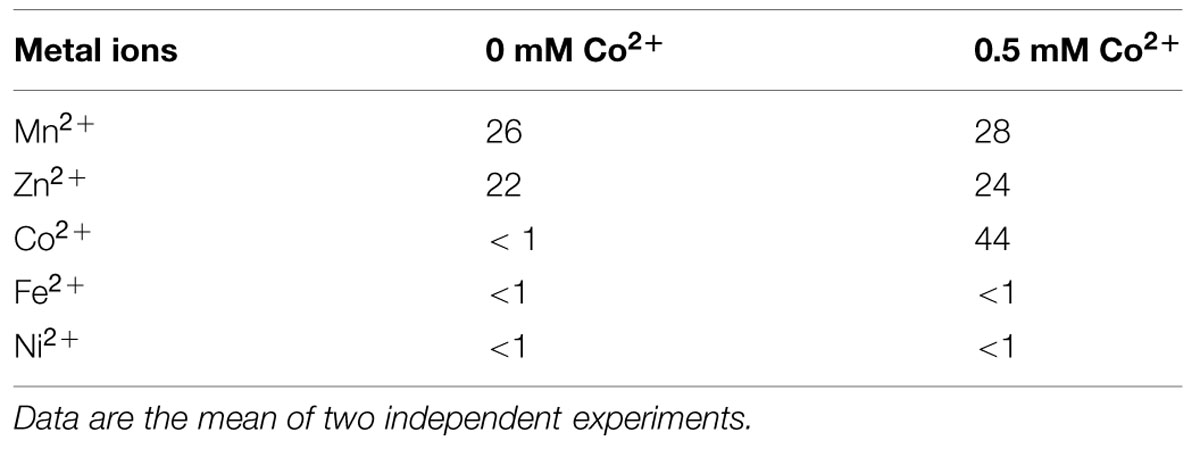
TABLE 4. Intracellular metal ion concentrations (μg g-1) of S. pneumoniae D39 grown in complete CDM with 0 mM and 0.5 mM Co2+.
Binding of PsaR to its Target is Mn2+ and Co2+-Dependent
To find out whether Co2+ directly affects the interaction of PsaR binding with PpsaB, PpcpA, and PprtA, EMSAs were performed with purified Strep-tagged PsaR (PsaR-Strep) protein and 33P-labeled promoter regions of psaB, pcpA, prtA, and adcR. The promoter region of adcR was taken as negative control. PsaR-Strep was unable to shift the promoter region of pcpA in the absence of metal ions (Lane 2 in Figure 4A). In the presence of 0.05 mM Mn2+ a slight shift was seen, while at 0.1 mM and 0.2 mM Mn2+, a complete shift of the promoter region of pcpA was observed (Lanes 3, 4, and 5 in Figure 4A), which is in agreement with a previous study (Kloosterman et al., 2008). Interestingly, PsaR-Strep also shifted the pcpA promoter fragment in the presence of 0.05 mM, 0.2 mM and 0.4 mM Co2+ (Lanes 6, 7, and 8 in Figure 4A). No shift was observed when the EMSAs were done in the presence of EDTA in reactions with otherwise the same conditions (Figure 4B). EMSAs were also performed in the presence of different metal ions, including Mn2+, Co2+, Zn2+, Cu2+, Fe2+, and Ni2+. No shift was observed with the tested metal ions except with Mn2+ and Co2+, which indicate that the PsaR-promoter interaction occurs specifically with Mn2+ and Co2+ (Figure 4C). Under the same conditions we did not see any shift with PadcR as a negative control (Figure 4D). EMSAs were also done with PpsaB and PprtA, giving similar results as with PpcpA (Supplementary Figure S5).
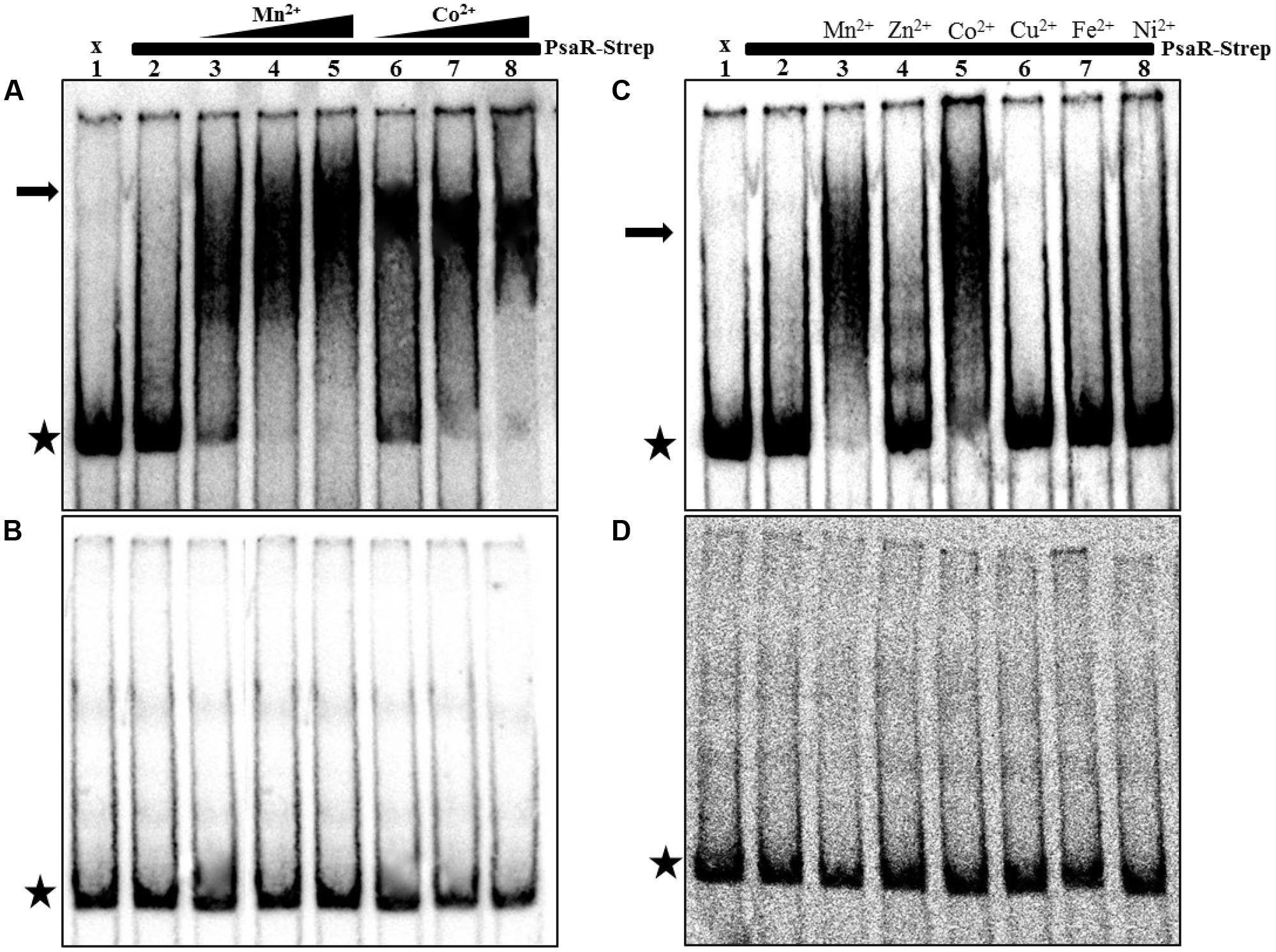
FIGURE 4. In vitro interaction of PsaR-Strep with the promoter region of pcpA. PsaR-Strep was added at concentration of 30 nM as indicated with horizontal bar above the lanes, while lane 1 is without protein. Arrows indicate the position of the shifted probe and asterisks indicate the position of the free probe. (A) Mn2+ was added in concentrations of 0.05 mM, 0.1 mM, and 0.2 mM as indicated by the triangular bar above lanes 3, 4, and 5. Co2+ was added in concentrations of 0.05 mM, 0.2 mM, and 0.4 mM as indicated by the triangular bar above lanes 6, 7, and 8, respectively. (B) The same experiment was done as described in (A), except that now 100 mM EDTA was added. (C) Metal ions were added as indicated above the lanes in concentrations of 0.2 mM. (D) The same experiment was done as described in (A), except that PadcR was used (negative control) instead of PpcpA.
Effect of Co2+on the Expression of the nrd and czcD Operons
Ribonucleotide reductases (nrd) usually catalyze the formation of deoxyribonucleotides necessary for DNA synthesis and DNA repair in almost all living organisms (Jordan and Reichard, 1998). Proper regulation of the nrd operon seems important for the cell. In E. coli and L. lactis, NrdD forms a complex with NrdG for specific ribonucleotide reductase activity (Torrents et al., 2001). In E. coli, the regulation of the nrd operon is mediated by two transcription factors, FNR and ArcA (Boston and Atlung, 2003). The nrd operon is highly upregulated in our transcriptome data under Co2+ stress and in previous studies also under Zn2+ and Cu2+ stress thus inhibiting the aerobic dNTP biosynthetic pathway (Kloosterman et al., 2008; Johnson et al., 2015). To validate our transcriptome data, we investigated the transcriptional response of PnrdD-lacZ to different concentrations of Co2+ and Zn2+ in CDM. Measurement of β-galactosidase activity showed that expression of PnrdD-lacZ is increased with increasing concentrations of Co2+ and Zn2+ (Figure 5). Expression of PnrdD-lacZ was twofold to threefold lower in the presence of Zn2+ as compared to Co2+. For future studies, it will be interesting to investigate what regulatory pathways govern the metal-dependent regulation of the nrd operon.
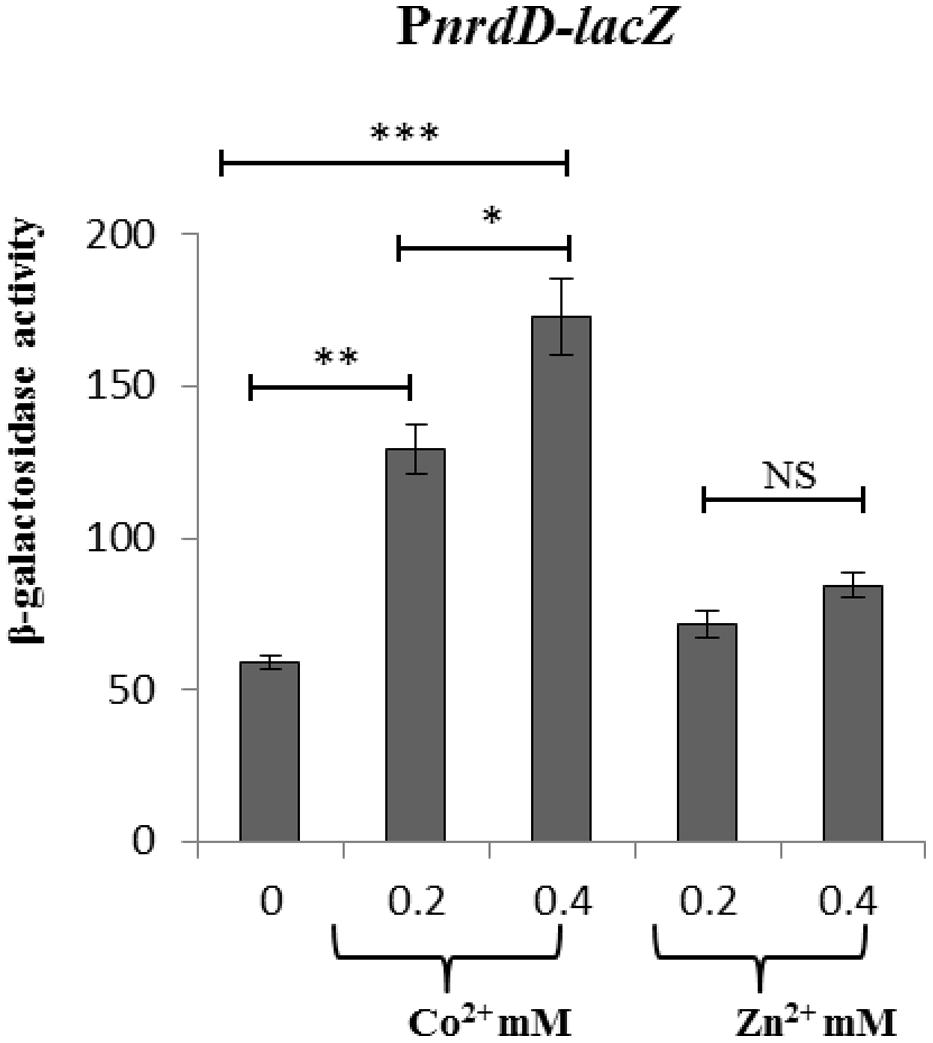
FIGURE 5. Expression level (in Miller units) of PnrdD-lacZ in D39 WT in CDM supplemented with different concentrations of Co2+ and Zn2+. SD of three independent replications is indicated with error bars. Statistical significance of the differences in the expression levels was determined by one-way ANOVA (NS, not significant, ∗P < 0.05, ∗∗P < 0.001, and ∗∗∗P < 0.0001).
Previously, it has been shown that expression of PczcD is increased by the presence of Co2+ in the undefined rich growth medium GM17, which was dependent on the metal-dependent activator SczA (Kloosterman et al., 2007). In addition, CzcD was found to contribute to resistance of cells to a high concentration of Co2+. We confirmed these results in the CDM medium that was used throughout this study (Supplementary Figure S6).
Discussion
In this study, we have explored Co2+-dependent gene expression in the human pathogen S. pneumoniae by whole transcriptome analysis. Several genes and operons with diverse functions were differentially expressed, including the regulon of the Mn2+-dependent transcriptional regulator PsaR, which is relevant for virulence, the Zn2+-resistance gene czcD, the putative Co2+-uptake operon cbi, and the nrd operon encoding genes involved in deoxyribonucleotides synthesis. The microarray results were confirmed by lacZ-reporter studies. Moreover, ICP-MS analysis showed that the transcriptional changes observed under Co2+ stress correlate with a high cell-associated Co2+ concentration, but not with changes in the concentration of other metal ions. Based on our in vitro studies of the interaction of PsaR with its target promoters, we propose that Co2+ leads to derepression of the regulon of the Mn2+-dependent transcriptional regulator PsaR by stimulating binding to its target promoters in a way that does not lead to repression as occurs with Mn2+.
Here, we present evidence that expression of the cbi operon, which is likely involved in the transport of Co2+, depends on the availability of Co2+. We could not obtain a deletion mutant of the cbi genes to study their effect on Co2+ homeostasis, probably because of polar effects on the essential downstream genes mreCD. However, the fact that the cbi genes are upregulated during Co2+ stress might indicate that their function is Co2+ export. This would mean that S. pneumoniae protects itself against Co2+ stress both via CzcD and the Cbi system. So far, a mechanism governing regulation of the cbi operon or similar genes in other organisms has not been studied. It is therefore interesting to search for a transcriptional regulator that mediates the Co2+-responsive expression of the cbi operon in S. pneumoniae. Of note, a putative transcriptional regulator is encoded in the cbi operon, and future experiments could be important to investigate whether this regulator is responsible for the Co2+-sensitive expression of the cbi operon. It is remarkable as well that two important cell division genes, namely mreC and mreD, are in the same operon with the cbi genes and that its expression is also Co2+ responsive. Although BLAST searches did not reveal linkage of mreCD to the cbi genes in other bacterial species, it would be interesting to investigate whether there is any biological reason for the presence of these genes in the same operon in S. pneumoniae.
Previously, it was shown that only Mn2+ and Zn2+ are responsible for the PsaR-mediated expression of the virulence genes psaBCA, pcpA, and prtA (PsaR regulon) and no role of Co2+ in the regulation of these genes was observed (Kloosterman et al., 2008). The previous study was done in the complex nutrient broth GM17 as a growth medium where Co2+ somehow was unable to stimulate expression of the PsaR regulon. GM17 may contain Co2+-chelating compounds that obscure the Co2+-dependent derepressive effect on the PsaR regulon. In the present work, we have demonstrated the role of Co2+ in the regulation of the PsaR regulon by using, instead of the complex GM17 medium, a CDM.
It has been shown before that competition between Mn2+ and Zn2+ results in Mn2+ deficiency in the cell possibly due to the involvement of the Mn2+-uptake transporter protein PsaA (Jacobsen et al., 2011). Additionally, it has been reported that PsaA has an ability to bind with other transition metal ions (Couñago et al., 2014), and Zn2+ and Cd2+ have the ability to inhibit Mn2+-uptake via PsaA (Eijkelkamp et al., 2014; Begg et al., 2015). Here, we performed ICP-MS analysis to check the intracellular concentration of Mn2+ in the presence of Co2+. Our ICP-MS analysis results showed that the intracellular concentration of Mn2+ is not affected by the addition of Co2+. This suggests that the expression of pcpA, psaBCA, and prtA is not derepressed by Co2+ due to Mn2+ starvation (Jacobsen et al., 2011), but instead might be a direct effect of an elevated intracellular Co2+ concentration.
Metal binding transcription factors can often bind to different metal ions and can therefore be at the cross-road of interplay between metal ions. For example, in B. subtilis CzrA is activated in the presence of Zn2+, while repressed in the presence of Cu2+ (Harvie et al., 2006). Similarly, the Cu2+-responsive regulator CopY regulates the expression of the cop operon in a Cu2+ and Zn2+-dependent way (Shafeeq et al., 2011b). Previously, the expression of PpcpA-lacZ, PpsaB-lacZ, and PprtA-lacZ has been shown to depend on the balance between the Mn2+ and Zn+2 concentrations, where Zn2+ derepresses the expression of these gene/operons and Mn2+ nullifies this expression via PsaR in GM17 medium (Kloosterman et al., 2008). Here, working with CDM, we have shown that the proper regulation of PsaR regulon is not only dependent on the balance between Mn2+ and Zn2+, but also on the balance between Mn2+ and Co2+. MntR, a DtxR family protein, represses the expression of a Mn2+-uptake system in B. subtilis (Que and Helmann, 2000). It has 15% sequence homology with PsaR in S. pneumoniae (Kloosterman et al., 2008). MntR also has the ability to bind with Cd2+, Zn2+, Ni2+, Cu2+, and Co2+ (Lieser et al., 2003; Golynskiy et al., 2005, 2007). Recent structural studies showed that Co2+ binding to MntR prevents the binding of Mn2+ (McGuire et al., 2013). The metal ion binding residues of MntR (D8, E99, E102, and H103) are also present in PsaR (D7, E99, E102, and H103), (Kloosterman et al., 2008; Lisher et al., 2013). Because the metal binding residues of MntR are conserved in PsaR, it is likely that Co2+ can also inhibit binding of Mn2+ to PsaR in an analogous way. Since Co2+, like Mn2+, stimulates binding of PsaR to its target promoters, we propose that this PsaR-Co2+ interaction with the promoter is ineffective in terms of repression of expression. Possibly, in the presence of Co2+, PsaR binds to the promoters of pcpA, prtA, and psaBCA, in such a way that it leads to derepression of the PsaR regulon. Whether the effects between Co2+ and Mn2+ as described in our work is, in conjunction with previously described interaction between Zn2+ and Mn2+ and Cd2+ and Mn2+ (Jacobsen et al., 2011; Begg et al., 2015), relevant for the in vivo situation, i.e., infection of the human body, remains a topic for future investigation.
Conflict of Interest Statement
The authors declare that the research was conducted in the absence of any commercial or financial relationships that could be construed as a potential conflict of interest.
Acknowledgments
IM is supported by the Government College University, Faisalabad, Pakistan under the faculty development program of HEC, Islamabad, Pakistan. OPK was supported by the European Union-funded Pneumopath Project HEALTH-F3-2009-222983.
Supplementary Material
The Supplementary Material for this article can be found online at: http://journal.frontiersin.org/article/10.3389/fmicb.2015.00748
References
Alimonti, A., Bocca, B., Mannella, E., Petrucci, F., Zennaro, F., Cotichini, R., et al. (2005). Assessment of reference values for selected elements in a healthy urban population. Ann. DellIstituto Super. Sanità 41, 181–187.
Avery, O. T., MacLeod, C. M., and McCarty, M. (1995). Studies on the chemical nature of the substance inducing transformation of pneumococcal types. Induction of transformation by a desoxyribonucleic acid fraction isolated from Pneumococcus type III. 1944. Mol. Med. Camb. Mass 1, 344–365.
Begg, S. L., Eijkelkamp, B. A., Luo, Z., Couñago, R. M., Morey, J. R., Maher, M. J., et al. (2015). Dysregulation of transition metal ion homeostasis is the molecular basis for cadmium toxicity in Streptococcus pneumoniae. Nat. Commun. 6, 6418. doi: 10.1038/ncomms7418
Bendezu, F. O., and de Boer, P. A. J. (2008). Conditional lethality, division defects, membrane involution, and endocytosis in mre and mrd shape mutants of Escherichia coli. J. Bacteriol. 190, 1792–1811. doi: 10.1128/JB.01322-7
Bethe, G., Nau, R., Wellmer, A., Hakenbeck, R., Reinert, R. R., Heinz, H. P., et al. (2001). The cell wall-associated serine protease PrtA: a highly conserved virulence factor of Streptococcus pneumoniae. FEMS Microbiol. Lett. 205, 99–104. doi: 10.1111/j.1574-6968.2001.tb10931.x
Blencowe, D. K., and Morby, A. P. (2003). Zn(II) metabolism in prokaryotes. FEMS Microbiol. Rev. 27, 291–311. doi: 10.1016/S0168-6445(03)00041-X
Bogaert, D., De Groot, R., and Hermans, P. W. M. (2004). Streptococcus pneumoniae colonisation: the key to pneumococcal disease. Lancet Infect. Dis. 4, 144–154. doi: 10.1016/S1473-3099(04)00938-7
Boston, T., and Atlung, T. (2003). FNR-mediated oxygen-responsive regulation of the nrdDG operon of Escherichia coli. J. Bacteriol. 185, 5310–5313. doi: 10.1128/JB.185.17.5310-5313.2003
Carballido-López, R., and Formstone, A. (2007). Shape determination in Bacillus subtilis. Curr. Opin. Microbiol. 10, 611–616. doi: 10.1016/j.mib.2007.09.008
Cheyns, K., Banza Lubaba Nkulu, C., Ngombe, L. K., Asosa, J. N., Haufroid, V., De Putter, T., et al. (2014). Pathways of human exposure to cobalt in Katanga, a mining area of the D.R. Congo. Sci. Total Environ. 490, 313–321. doi: 10.1016/j.scitotenv.2014.05.014
Couñago, R. M., Ween, M. P., Begg, S. L., Bajaj, M., Zuegg, J., O’Mara, M. L., et al. (2014). Imperfect coordination chemistry facilitates metal ion release in the Psa permease. Nat. Chem. Biol. 10, 35–41. doi: 10.1038/nchembio.1382
Degen, O., and Eitinger, T. (2002). Substrate specificity of nickel/cobalt permeases: insights from mutants altered in transmembrane domains I and II. J. Bacteriol. 184, 3569–3577. doi: 10.1128/JB.184.13.3569-3577.2002
Degen, O., Kobayashi, M., Shimizu, S., and Eitinger, T. (1999). Selective transport of divalent cations by transition metal permeases: the Alcaligenes eutrophus HoxN and the Rhodococcus rhodochrous NhlF. Arch. Microbiol. 171, 139–145. doi: 10.1007/s002030050691
Dryden, S. C., and Dowhan, W. (1996). Isolation and expression of the Rhodobacter sphaeroides gene (pgsA) encoding phosphatidylglycerophosphate synthase. J. Bacteriol. 178, 1030–1038.
Dudev, T., and Lim, C. (2008). Metal binding affinity and selectivity in metalloproteins: insights from computational studies. Annu. Rev. Biophys. 37, 97–116. doi: 10.1146/annurev.biophys.37.032807.125811
Eijkelkamp, B. A., Morey, J. R., Ween, M. P., Ong, C. Y., McEwan, A. G., Paton, J. C., et al. (2014). Extracellular zinc competitively inhibits manganese uptake and compromises oxidative stress management in Streptococcus pneumoniae. PLoS ONE 9:e89427. doi: 10.1371/journal.pone.0089427
Golynskiy, M. V., Davis, T. C., Helmann, J. D., and Cohen, S. M. (2005). Metal-induced structural organization and stabilization of the metalloregulatory protein MntR. Biochemistry (Mosc.) 44, 3380–3389. doi: 10.1021/bi0480741
Golynskiy, M., Li, S., Woods, V. L., and Cohen, S. M. (2007). Conformational studies of the manganese transport regulator (MntR) from Bacillus subtilis using deuterium exchange mass spectrometry. J. Biol. Inorg. Chem. JBIC Publ. Soc. Biol. Inorg. Chem. 12, 699–709. doi: 10.1007/s00775-007-0216-z
Gupta, R., Shah, P., and Swiatlo, E. (2009). Differential gene expression in Streptococcus pneumoniae in response to various iron sources. Microb. Pathog. 47, 101–109. doi: 10.1016/j.micpath.2009.05.003
Halfmann, A., Hakenbeck, R., and Brückner, R. (2007). A new integrative reporter plasmid for Streptococcus pneumoniae. FEMS Microbiol. Lett. 268, 217–224. doi: 10.1111/j.1574-6968.2006.00584.x
Harvie, D. R., Andreini, C., Cavallaro, G., Meng, W., Connolly, B. A., Yoshida, K., et al. (2006). Predicting metals sensed by ArsR-SmtB repressors: allosteric interference by a non-effector metal. Mol. Microbiol. 59, 1341–1356. doi: 10.1111/j.1365-2958.2006.05029.x
Honsa, E. S., Johnson, M. D. L., and Rosch, J. W. (2013). The roles of transition metals in the physiology and pathogenesis of Streptococcus pneumoniae. Front. Cell. Infect. Microbiol. 3:92. doi: 10.3389/fcimb.2013.00092
Hoskins, J., Alborn, W. E. Jr., Arnold, J., Blaszczak, L. C., Burgett, S., DeHoff, B. S., et al. (2001). Genome of the bacterium Streptococcus pneumoniae strain R6. J. Bacteriol. 183, 5709–5717. doi: 10.1128/JB.183.19.5709-5717.2001
Irving, H., and Williams, R. J. P. (1953). The stability of transition-metal complexes. J. Chem. Soc. Resumed. 637, 3192–3210. doi: 10.1039/JR9530003192
Jacobsen, F. E., Kazmierczak, K. M., Lisher, J. P., Winkler, M. E., and Giedroc, D. P. (2011). Interplay between manganese and zinc homeostasis in the human pathogen Streptococcus pneumoniae. Met. Integr. Biometal. Sci. 3, 38–41. doi: 10.1039/C0MT00050G
Jantzen, C., Jørgensen, H. L., Duus, B. R., Sporring, S. L., and Lauritzen, J. B. (2013). Chromium and cobalt ion concentrations in blood and serum following various types of metal-on-metal hip arthroplasties. Acta Orthop. 84, 229–236. doi: 10.3109/17453674.2013.792034
Johnson, M. D. L., Kehl-Fie, T. E., and Rosch, J. W. (2015). Copper intoxication inhibits aerobic nucleotide synthesis in Streptococcus pneumoniae. Met. Integr. Biometal Sci. 7, 786–794. doi: 10.1039/c5mt00011d
Johnston, J. W., Briles, D. E., Myers, L. E., and Hollingshead, S. K. (2006). Mn2+-dependent regulation of multiple genes in Streptococcus pneumoniae through PsaR and the resultant impact on virulence. Infect. Immun. 74, 1171–1180. doi: 10.1128/IAI.74.2.1171-1180.2006
Jordan, A., and Reichard, P. (1998). Ribonucleotide reductases. Annu. Rev. Biochem. 67, 71–98. doi: 10.1146/annurev.biochem.67.1.71
Kadioglu, A., Weiser, J. N., Paton, J. C., and Andrew, P. W. (2008). The role of Streptococcus pneumoniae virulence factors in host respiratory colonization and disease. Nat. Rev. Microbiol. 6, 288–301. doi: 10.1038/nrmicro1871
Kim, S.-N., Bae, Y.-G., and Rhee, D.-K. (2008). Dual regulation of dnaK and groE operons by HrcA and Ca++ in Streptococcus pneumoniae. Arch. Pharm. Res. 31, 462–467. doi: 10.1007/s12272-001-1179-4
Kloosterman, T. G., Bijlsma, J. J. E., Kok, J., and Kuipers, O. P. (2006a). To have neighbour’s fare: extending the molecular toolbox for Streptococcus pneumoniae. Microbiol. Read. Engl. 152, 351–359. doi: 10.1099/mic.0.2852128520
Kloosterman, T. G., Hendriksen, W. T., Bijlsma, J. J. E., Bootsma, H. J., van Hijum, S. A. F. T., Kok, J., et al. (2006b). Regulation of glutamine and glutamate metabolism by GlnR and GlnA in Streptococcus pneumoniae. J. Biol. Chem. 281, 25097–25109. doi: 10.1074/jbc.M601661200
Kloosterman, T. G., van der Kooi-Pol, M. M., Bijlsma, J. J. E., and Kuipers, O. P. (2007). The novel transcriptional regulator SczA mediates protection against Zn2+ stress by activation of the Zn2+-resistance gene czcD in Streptococcus pneumoniae. Mol. Microbiol. 65, 1049–1063. doi: 10.1111/j.1365-2958.2007.05849.x
Kloosterman, T. G., Witwicki, R. M., van der Kooi-Pol, M. M., Bijlsma, J. J. E., and Kuipers, O. P. (2008). Opposite effects of Mn2+ and Zn2+ on PsaR-mediated expression of the virulence genes pcpA, prtA, and psaBCA of Streptococcus pneumoniae. J. Bacteriol. 190, 5382–5393. doi: 10.1128/JB.00307-8
Kubo, M., Pierro, D. J., Mochizuki, Y., Kojima, T., Yamazaki, T., Satoh, S., et al. (1996). Bacillus stearothermophilus cell shape determinant gene, mreC and mreD, and their stimulation of protease production in Bacillus subtilis. Biosci. Biotechnol. Biochem. 60, 271–276. doi: 10.1271/bbb.60.271
Kuipers, O. P., de Ruyter, P. G. G., Kleerebezem, M., and de Vos, W. M. (1998). Quorum sensing-controlled gene expression in lactic acid bacteria. J. Biotechnol. 64, 15–21. doi: 10.1016/S0168-1656(98)00100-X
Kwon, H.-Y., Kim, S.-N., Pyo, S.-N., and Rhee, D.-K. (2005). Ca2+-dependent expression of the CIRCE regulon in Streptococcus pneumoniae. Mol. Microbiol. 55, 456–468. doi: 10.1111/j.1365-2958.2004.04416.x
Land, A. D., and Winkler, M. E. (2011). The requirement for pneumococcal MreC and MreD is relieved by inactivation of the gene encoding PBP1a. J. Bacteriol. 193, 4166–4179. doi: 10.1128/JB.052455211
Lanie, J. A., Ng, W.-L., Kazmierczak, K. M., Andrzejewski, T. M., Davidsen, T. M., Wayne, K. J., et al. (2007). Genome sequence of Avery’s virulent serotype 2 strain D39 of Streptococcus pneumoniae and comparison with that of unencapsulated laboratory strain R6. J. Bacteriol. 189, 38–51. doi: 10.1128/JB.01148-6
Lieser, S. A., Davis, T. C., Helmann, J. D., and Cohen, S. M. (2003). DNA-binding and oligomerization studies of the manganese(II) metalloregulatory protein MntR from Bacillus subtilis. Biochemistry (Mosc.) 42, 12634–12642. doi: 10.1021/bi0350248
Lippard, S. J., and Berg, J. M. (1994). Principles of Bioinorganic Chemistry. Mill Valley, CA: University Science Books, 411.
Lisher, J. P., Higgins, K. A., Maroney, M. J., and Giedroc, D. P. (2013). Physical characterization of the manganese-sensing pneumococcal surface antigen repressor from Streptococcus pneumoniae. Biochemistry (Mosc.) 52, 7689–7701. doi: 10.1021/bi401132w
Lorca, G. L., Barabote, R. D., Zlotopolski, V., Tran, C., Winnen, B., Hvorup, R. N., et al. (2007). Transport Capabilities of eleven gram-positive bacteria: comparative genomic analyses. Biochim. Biophys. Acta 1768, 1342–1366. doi: 10.1016/j.bbamem.2007.02.007
MacGilvray, M. E., Lapek, J. D. Jr., Friedman, A. E., and Quivey, R. G. Jr. (2012). Cardiolipin biosynthesis in Streptococcus mutans is regulated in response to external pH. Microbiol. Read. Engl. 158, 2133–2143. doi: 10.1099/mic.0.057273-0
McAllister, L. J., Tseng, H.-J., Ogunniyi, A. D., Jennings, M. P., McEwan, A. G., and Paton, J. C. (2004). Molecular analysis of the psa permease complex of Streptococcus pneumoniae. Mol. Microbiol. 53, 889–901. doi: 10.1111/j.1365-2958.2004.04164.x
McGuire, A. M., Cuthbert, B. J., Ma, Z., Grauer-Gray, K. D., Brunjes Brophy, M., Spear, K. A., et al. (2013). Roles of the A and C sites in the manganese-specific activation of MntR. Biochemistry (Mosc.) 52, 701–713. doi: 10.1021/bi301550t
Mirza, S., Wilson, L., Benjamin, W. H. Jr., Novak, J., Barnes, S., Hollingshead, S. K., et al. (2011). Serine protease PrtA from Streptococcus pneumoniae plays a role in the killing of S. pneumoniae by apolactoferrin. Infect. Immun. 79, 2440–2450. doi: 10.1128/IAI.00489-0
Mitchell, T. J. (2003). The pathogenesis of streptococcal infections: from tooth decay to meningitis. Nat. Rev. Microbiol. 1, 219–230. doi: 10.1038/nrmicro771
Moore, C. M., and Helmann, J. D. (2005). Metal ion homeostasis in Bacillus subtilis. Curr. Opin. Microbiol. 8, 188–195. doi: 10.1016/j.mib.2005.02.007
Nies, D. H. (1992). Resistance to cadmium, cobalt, zinc, and nickel in microbes. Plasmid 27, 17–28. doi: 10.1016/0147-619X(92)90003-S
Nies, D. H. (2003). Efflux-mediated heavy metal resistance in prokaryotes. FEMS Microbiol. Rev. 27, 313–339. doi: 10.1016/S0168-6445(03)00048-2
Obaro, S., and Adegbola, R. (2002). The pneumococcus: carriage, disease and conjugate vaccines. J. Med. Microbiol. 51, 98–104.
Que, Q., and Helmann, J. D. (2000). Manganese homeostasis in Bacillus subtilis is regulated by MntR, a bifunctional regulator related to the diphtheria toxin repressor family of proteins. Mol. Microbiol. 35, 1454–1468. doi: 10.1046/j.1365-2958.2000.01811.x
Raimunda, D., Long, J. E., Padilla-Benavides, T., Sassetti, C. M., and Argüello, J. M. (2014). Differential roles for the Co(2+) /Ni(2+) transporting ATPases, CtpD and CtpJ, in Mycobacterium tuberculosis virulence. Mol. Microbiol. 91, 185–197. doi: 10.1111/mmi.12454
Remy, L., Carrière, M., Derré-Bobillot, A., Martini, C., Sanguinetti, M., and Borezée-Durant, E. (2013). The Staphylococcus aureus Opp1 ABC transporter imports nickel and cobalt in zinc-depleted conditions and contributes to virulence. Mol. Microbiol. 87, 730–743. doi: 10.1111/mmi.12126
Rodionov, D. A., Hebbeln, P., Gelfand, M. S., and Eitinger, T. (2006). Comparative and functional genomic analysis of prokaryotic nickel and cobalt uptake transporters: evidence for a novel group of ATP-binding cassette transporters. J. Bacteriol. 188, 317–327. doi: 10.1128/JB.188.1.317-327.2006
Roth, J. R., Lawrence, J. G., Rubenfield, M., Kieffer-Higgins, S., and Church, G. M. (1993). Characterization of the cobalamin (vitamin B12) biosynthetic genes of Salmonella typhimurium. J. Bacteriol. 175, 3303–3316.
Sánchez-Beato, A. R., López, R., and García, J. L. (1998). Molecular characterization of PcpA: a novel choline-binding protein of Streptococcus pneumoniae. FEMS Microbiol. Lett. 164, 207–214. doi: 10.1111/j.1574-6968.1998.tb13087.x
Shafeeq, S., Afzal, M., Henriques-Normark, B., and Kuipers, O. P. (2015). Transcriptional profiling of UlaR-regulated genes in Streptococcus pneumoniae. Genomics Data 4, 57–59. doi: 10.1016/j.gdata.2015.02.004
Shafeeq, S., Kloosterman, T. G., and Kuipers, O. P. (2011a). Transcriptional response of Streptococcus pneumoniae to Zn2+) limitation and the repressor/activator function of AdcR. Met. Integr. Biometal Sci. 3, 609–618. doi: 10.1039/c1mt00030f
Shafeeq, S., Yesilkaya, H., Kloosterman, T. G., Narayanan, G., Wandel, M., Andrew, P. W., et al. (2011b). The cop operon is required for copper homeostasis and contributes to virulence in Streptococcus pneumoniae. Mol. Microbiol. 81, 1255–1270. doi: 10.1111/j.1365-2958.2011.07758.x
Shafeeq, S., Kuipers, O. P., and Kloosterman, T. G. (2013). The role of zinc in the interplay between pathogenic streptococci and their hosts. Mol. Microbiol. 88, 1047–1057. doi: 10.1111/mmi.12256
Slager, J., Kjos, M., Attaiech, L., and Veening, J.-W. (2014). Antibiotic-induced replication stress triggers bacterial competence by increasing gene dosage near the origin. Cell 157, 395–406. doi: 10.1016/j.cell.2014.01.068
Sun, X., Yu, G., Xu, Q., Li, N., Xiao, C., Yin, X., et al. (2013). Putative cobalt- and nickel-binding proteins and motifs in Streptococcus pneumoniae. Met. Integr. Biometal Sci. 5, 928–935. doi: 10.1039/c3mt00126a
Torrents, E., Eliasson, R., Wolpher, H., Gräslund, A., and Reichard, P. (2001). The anaerobic ribonucleotide reductase from Lactococcus lactis. Interactions between the two proteins NrdD and NrdG. J. Biol. Chem. 276, 33488–33494. doi: 10.1074/jbc.M103743200
Tottey, S., Waldron, K. J., Firbank, S. J., Reale, B., Bessant, C., Sato, K., et al. (2008). Protein-folding location can regulate manganese-binding versus copper- or zinc-binding. Nature 455, 1138–1142. doi: 10.1038/nature07340
Keywords: Co2+, Mn2+, PsaR, Streptococcus pneumoniae, transcriptional regulation
Citation: Manzoor I, Shafeeq S, Kloosterman TG and Kuipers OP (2015) Co2+-dependent gene expression in Streptococcus pneumoniae: opposite effect of Mn2+ and Co2+ on the expression of the virulence genes psaBCA, pcpA, and prtA. Front. Microbiol. 6:748. doi: 10.3389/fmicb.2015.00748
Received: 24 March 2015; Accepted: 08 July 2015;
Published: 24 July 2015.
Edited by:
Biswarup Mukhopadhyay, Virginia Polytechnic Institute and State University, USAReviewed by:
Jason W. Rosch, St. Jude Children’s Research Hospital, USAGrace Ann Spatafora, Middlebury College, USA
Copyright © 2015 Manzoor, Shafeeq, Kloosterman and Kuipers. This is an open-access article distributed under the terms of the Creative Commons Attribution License (CC BY). The use, distribution or reproduction in other forums is permitted, provided the original author(s) or licensor are credited and that the original publication in this journal is cited, in accordance with accepted academic practice. No use, distribution or reproduction is permitted which does not comply with these terms.
*Correspondence: Oscar P. Kuipers, Department of Molecular Genetics, Groningen Biomolecular Sciences and Biotechnology Institute, University of Groningen, Nijenborgh 7, 9747 AG, Groningen, Netherlands,by5wLmt1aXBlcnNAcnVnLm5s
 Irfan Manzoor
Irfan Manzoor Sulman Shafeeq
Sulman Shafeeq Tomas G. Kloosterman
Tomas G. Kloosterman Oscar P. Kuipers
Oscar P. Kuipers